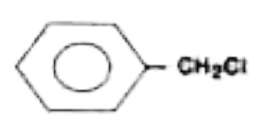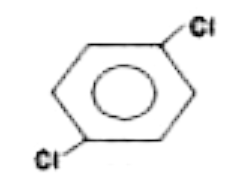Which of the following alkyl group are possible from iso-butene ?
Iso-Butyl & n-butyl
Sec. butyl & Ter. Butyl
n-butyl & Ter. Butyl
iso-butyl & Ter. Butyl
To determine which alkyl groups can be formed from iso-butene, we will analyze the structure of iso-butene and the possible alkyl groups that can be derived from it.
1. Draw the Structure of Iso-Butene:
Iso-butene (also known as 2-methylpropene) has the following structure:
CH2|CH3−CH−CH=CH2|CH3
Here, the double bond is between the second and third carbon atoms.
2. Identify Possible Alkyl Groups:
- Tertiary Butyl Group (tert-butyl):
If we consider the carbon atom involved in the double bond (the second carbon), it can form a tertiary butyl group when a functional group is attached to it. This carbon is attached to three other carbon atoms (one from the methyl group and two from the propene chain), making it a tertiary carbon.
- Structure:
CH3|CH3−C−R|CH2
where R is the functional group.
- N-Butyl Group:
The terminal carbon (the fourth carbon) can also form a normal butyl group (n-butyl) when a functional group is attached to it. This carbon is attached to three other carbon atoms (one from the methyl group and two from the propene chain), making it a primary carbon.
- Structure:
CH3−CH2−CH2−CH2−R
where R is the functional group.
3. Secondary Butyl Group:
- A secondary butyl group cannot be formed from iso-butene because there is no carbon in iso-butene that is attached to two other carbon atoms and has a double bond that can be opened to create a secondary carbon.
4. Conclusion:
The possible alkyl groups that can be formed from iso-butene are:
- Tertiary butyl (tert-butyl)
- N-butyl (n-butyl)
Final Answer:
The alkyl groups possible from iso-butene are tert-butyl and n-butyl.
Iso-butene (also known as 2-methylpropene) has the following structure:
CH2|CH3−CH−CH=CH2|CH3
Here, the double bond is between the second and third carbon atoms.
- Tertiary Butyl Group (tert-butyl):
If we consider the carbon atom involved in the double bond (the second carbon), it can form a tertiary butyl group when a functional group is attached to it. This carbon is attached to three other carbon atoms (one from the methyl group and two from the propene chain), making it a tertiary carbon.
- Structure:
CH3|CH3−C−R|CH2
where R is the functional group.
The terminal carbon (the fourth carbon) can also form a normal butyl group (n-butyl) when a functional group is attached to it. This carbon is attached to three other carbon atoms (one from the methyl group and two from the propene chain), making it a primary carbon.
- Structure:
CH3−CH2−CH2−CH2−R
where R is the functional group.
- A secondary butyl group cannot be formed from iso-butene because there is no carbon in iso-butene that is attached to two other carbon atoms and has a double bond that can be opened to create a secondary carbon.
The possible alkyl groups that can be formed from iso-butene are:
- Tertiary butyl (tert-butyl)
- N-butyl (n-butyl)
The alkyl groups possible from iso-butene are tert-butyl and n-butyl.
Topper's Solved these Questions
Similar Questions
Knowledge Check
Which of the following is an aryl alkyl halide.
A B
B C
C DNone of these
DNone of these
Which of the following alkyl halides is iso -butyl bromide ?
View SolutionWhich of the following alkane is synthesised from single alkyl halide by wurtz reaction:-
View SolutionWhich of the following pair is iso-electronic : -
View SolutionWhich alkyl groups can originate from propane ?
View SolutionWhich of the following pair of species are iso-electronic ?
View SolutionWrite the graphic formulae of the following alkyl groups : ethyl, n-propyl, iso-propyl, sec-butyl, t-butyl.
View SolutionIn which of the following, functional group isomerism is not possible ?
View Solution
